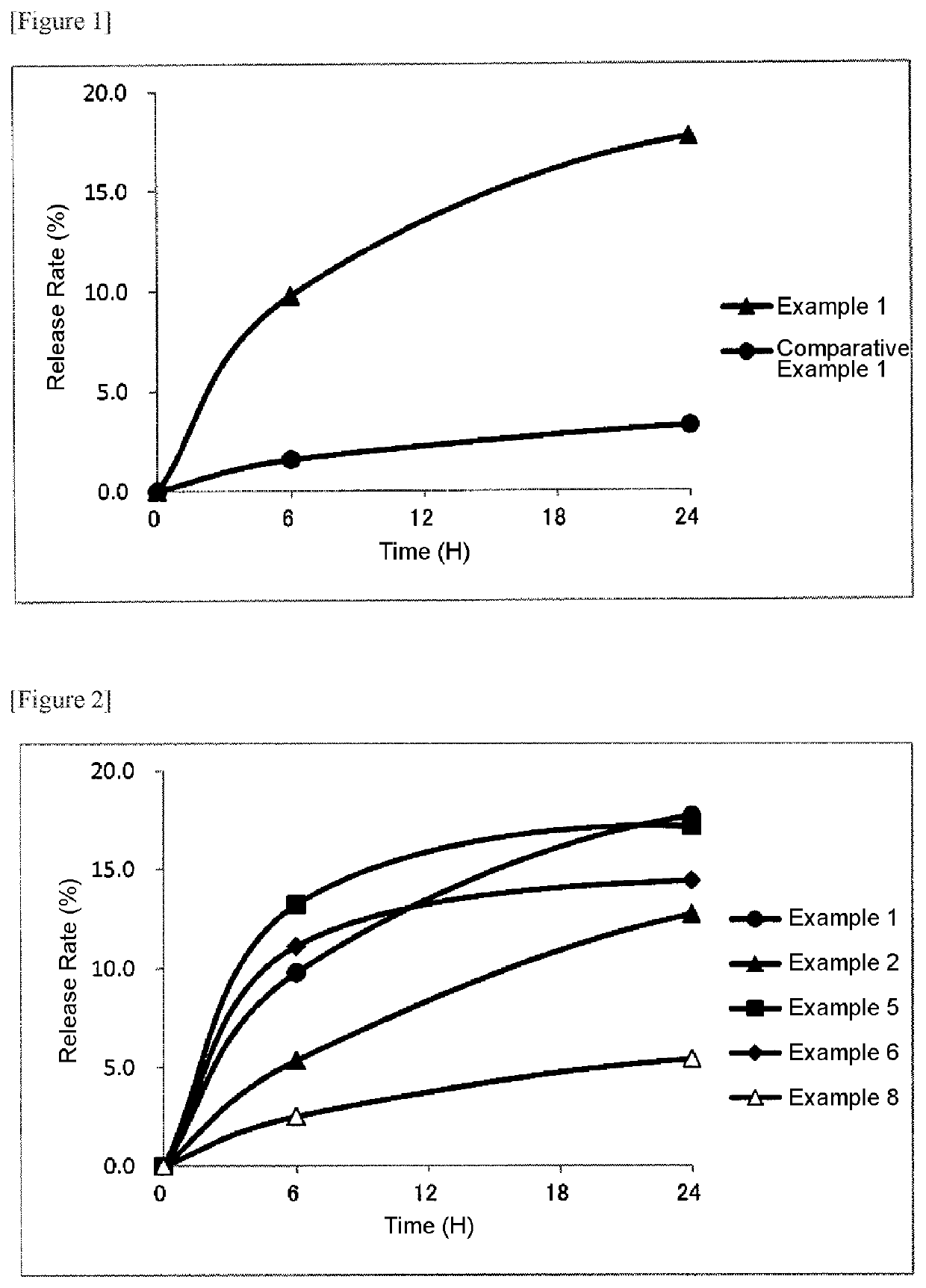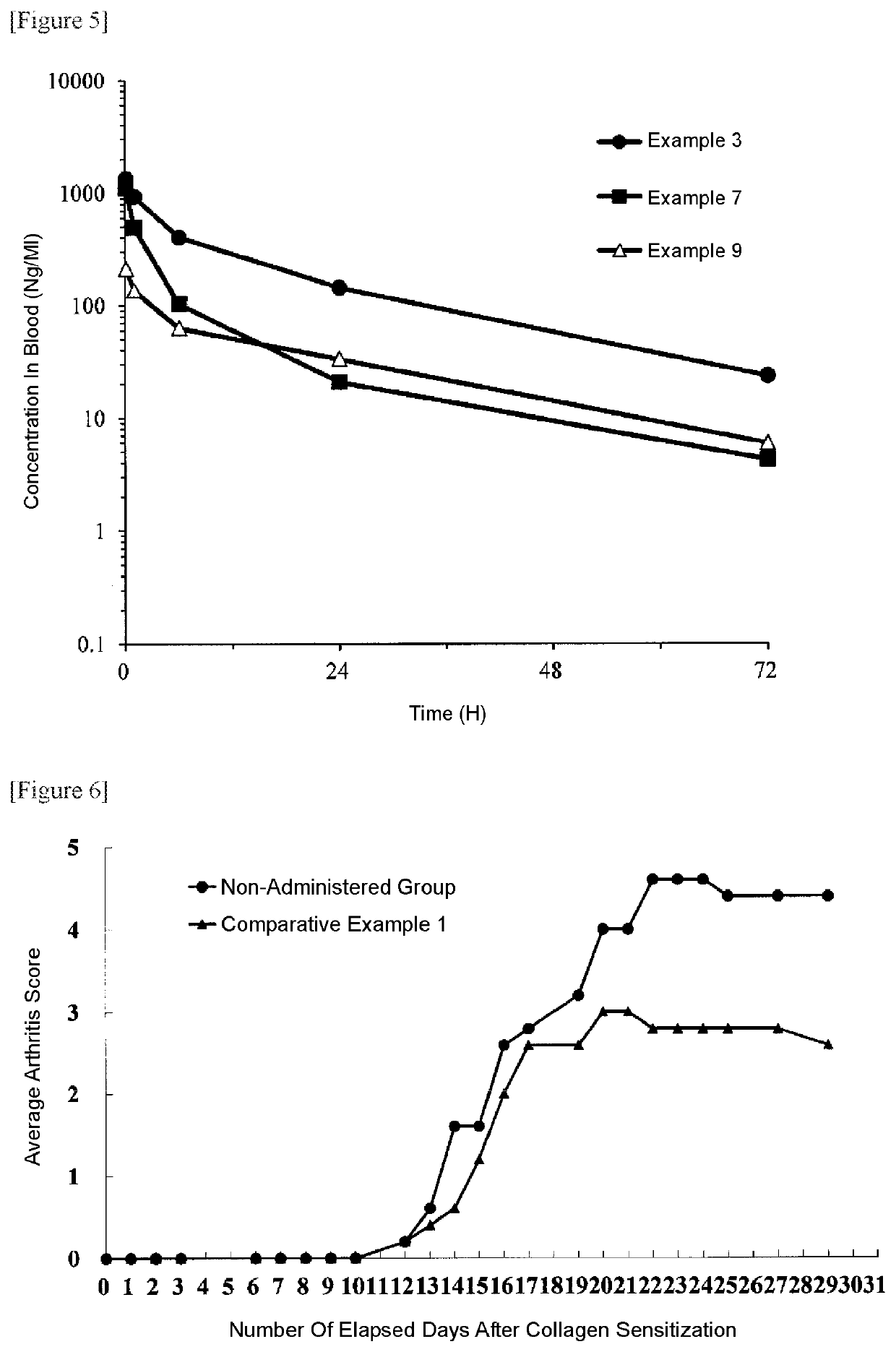Polymer derivative of macrolide immunosuppressant
a macrolide and immunosuppressant technology, applied in the field of polymer derivatives of macrolidebased compounds, can solve the problems of poor immunosuppression effect, renal toxicity and pancreatic toxicity of tacrolimus, and low bioavailability at the time of oral administration, and achieve excellent blood retentivity, excellent therapeutic effect, and stable in vivo
- Summary
- Abstract
- Description
- Claims
- Application Information
AI Technical Summary
Benefits of technology
Problems solved by technology
Method used
Image
Examples
synthesis example 1
[0176]Synthesis of Polyethylene Glycol-αρ-Polyaspartic Acid Block Copolymer (Polyethylene Glycol Molecular Weight: 12,000, Degree of Polymerization of Polyaspartic Acid: 95) (Compound 1)
[0177]A polyethylene glycol having a methoxy group at one end and a 3-aminopropyl group at another end (SUNBRIGHT MEPA-12T, manufactured by NOF Corp., average molecular weight 12 kilodaltons, 10.0 g) was dissolved in dimethyl sulfoxide (DMSO, 130 mL), subsequently γ-benzyl-L-aspartic acid-N-carboxylic acid anhydride (BLA-NCA, 13.8 g, 200 equivalents) was added to the solution, and the mixture was stirred overnight at 32.0° C. The reaction liquid was added dropwise for one hour to a mixed solvent of ethanol (755 mL) and diisopropyl ether (3,101 L), and the mixture was stirred for one hour at room temperature. A precipitate was collected by filtration and then dried in a vacuum, and thus a solid (41.8 g) was obtained.
[0178]The solid (40.0 g) thus obtained was dissolved in N,N-dimethylformamide (DMF, 80...
synthesis example 2
[0179]Synthesis of Polyethylene Glycol-αβ-Polyaspartic Acid Block Copolymer (Polyethylene Glycol Molecular Weight: 12,000, Degree of Polymerization of Polyaspartic Acid: 43) (Compound 2)
[0180]The indicated Compound 2 was obtained by using 52.2 equivalents of BLA-NCA for a polyethylene glycol having a methoxy group at one end and a 3-aminopropyl group at another end, according to the method described in Synthesis Example 1. The degree of polymerization of aspartic acid in one molecule of the present compound based on the titration value obtained using a 0.1 N potassium hydroxide solution was 43.2.
synthesis example 3
[0181]Synthesis of Polyethylene Glycol-αβ-Polyaspartic Acid Block Copolymer (Polyethylene Glycol Molecular Weight: 12,000, Degree of Polymerization of Polyaspartic Acid: 73) (Compound 3)
[0182]A polyethylene glycol having a methoxy group at one end and a 3-aminopropyl group at another end (SUNBRIGHT MEPA-12T, manufactured by NOF Corp., average molecular weight 12 kilodaltons, 10.0 g) was dissolved in DMSO (190 mL), subsequently BLA-NCA (8.89 g, 129 equivalents) was added to the solution, and the mixture was stirred overnight at 32° C. The reaction liquid was added dropwise for one hour to a mixed solvent of ethanol (400 mL) and diisopropyl ether (1,600 mL), and the mixture was stirred for one hour at room temperature. A precipitate was collected by filtration and then dried in a vacuum, and a solid (26.5 g) was obtained.
[0183]The solid (23.0 g) thus obtained was dissolved in acetonitrile (460 mL), and acetic anhydride (724 mL) was added to the solution. The mixture was stirred for 3 ...
PUM
| Property | Measurement | Unit |
|---|---|---|
| average molecular weight | aaaaa | aaaaa |
| molecular weight | aaaaa | aaaaa |
| molecular weight | aaaaa | aaaaa |
Abstract
Description
Claims
Application Information
 Login to View More
Login to View More - R&D
- Intellectual Property
- Life Sciences
- Materials
- Tech Scout
- Unparalleled Data Quality
- Higher Quality Content
- 60% Fewer Hallucinations
Browse by: Latest US Patents, China's latest patents, Technical Efficacy Thesaurus, Application Domain, Technology Topic, Popular Technical Reports.
© 2025 PatSnap. All rights reserved.Legal|Privacy policy|Modern Slavery Act Transparency Statement|Sitemap|About US| Contact US: help@patsnap.com



